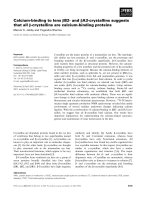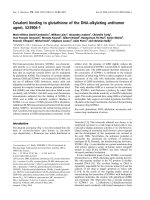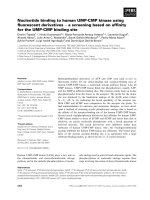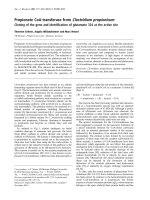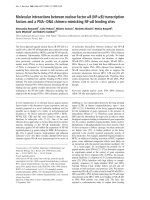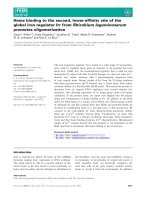Báo cáo y học: "DEK binding to class II MHC Y-box sequences is gene- and allele-specific" pptx
Bạn đang xem bản rút gọn của tài liệu. Xem và tải ngay bản đầy đủ của tài liệu tại đây (515.52 KB, 8 trang )
R226
Introduction
Although juvenile rheumatoid arthritis (JRA) is the most
common cause of disability in children, its etiology is
unknown. Immune dysregulation appears to play a key
pathogenic role, as circulating autoantibodies are common
in patients with certain JRA clinical subtypes [1–7]. Two
recent studies have shown a highly significant association
between early-onset pauciarticular JRA and circulating
antibodies to the 43-kDa nuclear protein DEK [8,9].
Although circulating DEK antibodies have subsequently
been found in children and adults with other autoimmune
diseases [10,11], these two studies did reveal that chil-
dren with JRA are significantly more likely to have anti-DEK
antibodies than are children without rheumatic disease.
Children with pauciarticular-onset JRA were also signifi-
cantly more likely to have anti-DEK antibodies than were
children with polyarticular-onset or systemic-onset JRA or
other rheumatic diseases. Among children with pauciartic-
ular JRA, DEK autoantibodies were significantly more
common in those with JRA-associated uveitis than in
those without eye disease [8,9]. DEK reactivity was also
found to be strongly associated with onset of any JRA
subtype before age 6 years [8].
DEK is a nuclear protein that is not structurally related to
any known family of proteins [12,13]. Although it may also
participate in DNA replication and RNA processing
[14,15], we have identified DEK as a DNA-binding protein
that recognizes the TG-rich peri-ets (pets) regulatory
element in the human immunodeficiency virus type 2
(HIV-2) enhancer [16]. The pets site is important in medi-
ating HIV-2 enhancer stimulation in activated T cells and
bp = base pair(s); EMSA = electrophoretic mobility shift assay; HIV = human immunodeficiency virus; JRA = juvenile rheumatoid arthritis; K
d[app]
=
apparent dissociation constant; PCR = polymerase chain reaction; pets = peri-ets; rDEK = recombinant DEK protein.
Arthritis Research & Therapy Vol 5 No 4 Adams et al.
Research article
DEK binding to class II MHC Y-box sequences is gene- and
allele-specific
Barbara S Adams,
1
Hyuk C Cha,
1
Joanne Cleary,
2
Haiying Tan,
1
Hongling Wang,
1
Kajal Sitwala,
2
David M Markovitz
2
1
Department of Pediatrics, Division of Pediatric Rheumatology, University of Michigan School of Medicine, Ann Arbor, MI, USA
2
Department of Internal Medicine, University of Michigan School of Medicine, Ann Arbor, MI, USA
Correspondence:
Received: 23 Sep 2002 Revisions requested: 1 Nov 2002 Revisions received: 8 Apr 2003 Accepted: 29 Apr 2003 Published: 23 May 2003
Arthritis Res Ther 2003, 5:R226-R233 (DOI 10.1186/ar774)
© 2003 Adams et al., licensee BioMed Central Ltd (Print ISSN 1478-6354; Online ISSN 1478-6362). This is an Open Access article: verbatim
copying and redistribution of this article are permitted in all media for any purpose, provided this notice is preserved along with the article's original
URL.
Abstract
Using electrophoretic mobility shift assays, we examined
sequence-specific binding of DEK, a potential autoantigen in
juvenile rheumatoid arthritis, to conserved Y-box regulatory
sequences in class II MHC gene promoters. Nuclear extracts
from several cell lines of different phenotypes contained
sequence-specific binding activity recognizing DRA,
DQA1*0101, and DQA1*0501 Y-box sequences. Participation
of both DEK and NF-Y in the DQA1 Y-box binding complex
was confirmed by ‘supershifting’ with anti-DEK and anti-NF-Y
antibodies. Recombinant DEK also bound specifically to the
DQA1*0101 Y box and to the polymorphic DQA1*0501 Y box,
but not to the consensus DRA Y box. Measurement of the
apparent dissociation constants demonstrated a two- to
fivefold difference in DEK binding to the DQA1 Y-box
sequence in comparison with other class II MHC Y-box
sequences. Residues that are crucial for DEK binding to the
DQA1*0101 Y box were identified by DNase I footprinting. The
specific characteristics of DEK binding to these related
sequences suggests a potential role for DEK in differential
regulation of class II MHC expression, and thus in the
pathogenesis of juvenile rheumatoid arthritis and other
autoimmune diseases.
Keywords: DEK, genetic polymorphism, HLA-DQA1, HLA-DRA, juvenile rheumatoid arthritis
Open Access
Available online />R227
monocytes [17–19], suggesting that DEK may play an
immunomodulatory role as it participates in transcriptional
activation through this and related sites.
Observed sequence similarity between the DEK-binding
site in HIV-2 and the highly conserved Y-box regulatory
element in MHC class II gene promoters pointed to the
Y box as one possible related site. NF-Y binding to the
MHC class II gene Y box anchors a complex assembly of
nuclear proteins that occupies several regulatory elements
over a great distance [20–22]. In the DQA1 promoter
Y box, a reverse CCAAT motif with a partially overlapping
TG-rich sequence shares sequence identity with the
HIV-2 DEK-binding site at 7 of 10 positions (Fig. 1). In the
DQA1*0501 allele, which is highly associated with predis-
position to autoimmune disease [23–27], the Y box con-
tains a single-nucleotide polymorphism that reduces
sequence identity to 6 of 10 positions. We hypothesized
that DEK could bind in a sequence-specific manner to the
Y-box motifs in the promoter regions of several class II
MHC genes, and that gene- and allele-specific Y-box poly-
morphisms could affect DEK binding activity. In this study,
we examine the characteristics of DEK binding to the
Y-box sequences of DQA1*0101, DQA1*0501, DRA,
DQB, and DRB. We also confirm participation of DEK
with NF-Y in the DQA1 Y-box binding complex and local-
ize specific DEK binding within this sequence. As the
Y-box promoter element is crucial to the regulation of
MHC class II gene expression, sequence-specific binding
to this motif indicates a potential role for DEK in modulat-
ing normal and abnormal immune response.
Materials and methods
Cell culture and preparation of nuclear extracts
Cultured cell lines were grown and harvested and nuclear
extracts were prepared from resting cells as previously
described [28,29].
Preparation of partially purified recombinant DEK protein
Construction of the poly-histidine-tagged DEK bacterial
expression vector is described elsewhere [16]. Full-length
DEK or antisense DEK was prepared from cultures grown
from individual colonies to log phase, induced with 1 mm
isopropyl thiogalactose, and harvested by centrifugation
after 4 hours. Recombinant protein was purified from bac-
terial lysates in accordance with the published method for
the QIAexpress system (Qiagen, Valencia, CA, USA) with
variations in Buffers B and D as noted in Supplementary
material. Procedures were carried out at 4°C; dialyzed
recombinant DEK protein (rDEK) was stored at –80°C.
Preparation of FLAG-DEK
A FLAG-tagged DEK adenoviral vector constructed by the
University of Michigan Vector Core was used to transduce
T98G cells (ATCC) by incubation for 48 hours before
harvesting for immunoprecipitation. FLAG-DEK was
immunoprecipitated using anti-FLAG resin (Sigma-Aldrich,
St Louis, MO, USA) in accordance with the manufactur-
er’s instructions and was eluted by competition with
peptide containing three FLAG recognition epitopes.
Electrophoretic mobility shift assays (EMSAs)
EMSAs were carried out as previously described [30],
using 0.1–0.25 ng of radiolabeled oligonucleotide probe
(2.5 × 10
4
counts per minute) per 15 µl binding reaction
and 5 µg of nuclear extract (except as noted) or <1 µg of
rDEK. For competition EMSAs, unlabeled double-stranded
oligonucleotide was added to reaction mixtures before the
radiolabeled probe. For antibody supershift of binding
complexes, 1 µl anti-NF-YA antibody (gift of JP-Y Ting) or
1 µl high-titer anti-DEK human serum (gift of W Szer [9])
or 2–3 µl control human serum was added to the binding
reaction, and the mixture was incubated on ice for 2 hours
before the probe was added.
Sequence of oligonucleotide probes and competitors
See Fig. 1.
Measurement of apparent dissociation constants using
EMSA
The
32
P end-labeled oligonucleide probe (5 nM) was incu-
bated with immunoprecipitation-purified FLAG-rDEK in a
Figure 1
EMSA probes and competitors: HIV-2 DEK-binding site, class II MHC
Y-box motifs (DQA1, DRA, DQB, and DRB), and related sequences.
Probes and competitors include only sequences 3′ of the ᭹ symbol.
X boxes are shown to provide a broader context for the Y-box
regulatory element. EMSA = electrophoretic mobility shift assay.
Arthritis Research & Therapy Vol 5 No 4 Adams et al.
R228
range of concentrations from one tenth to 10 times the
estimated K
d[app]
(apparent dissociation constant) as
described elsewhere [31]. Protein-bound DNA was sepa-
rated from free probe as for EMSA in 1 × TBE (Tris-borate-
EDTA buffer: Tris 89 mM, borate 89 mM, EDTA 2 mM).
The dried gel was exposed to a phosphor screen
overnight, and the bands were quantified using a Molecu-
lar Dynamics Storm 840 Phosphorimager with Image-
Quant Software. The data were fit via nonlinear
least-squares regression to the single-site binding
isotherm:
% free DNA = K
d[app]
/( K
d[app]
+ [protein]).
From this equation, the apparent K
d
corresponds to the
protein concentration at which half of the DNA is bound [31].
DNAse I protection assay
The 148-bp probe included DQA1*0101 promoter
sequence from –53 to –200. PCR primer (200 ng) for
probe sequence was end-labeled with
32
Pγ-ATP and T4
polynucleotide kinase (New England Biolabs, Beverly, MA,
USA), and was column purified. Labeled antisense primer
(200 ng) and 200 ng unlabeled sense strand primer (or
vice versa) were used in each 50.5-µl PCR reaction, with
0.2 m
M dNTP, 1.5 mM MgCl
2
, 5 µl 10X PCR Buffer (Invitro-
gen, Carlsbad, CA, USA), and 1 µg Namalwa genomic
DNA. Taq polymerase (Invitrogen) was added at 80°C
after a 94°C ‘hot start,’ initiating 35 cycles of PCR: 94°C
for 45 s, 55°C for 30 s, and 72°C for 90 s, with final exten-
sion at 72°C for 10 min. PCR products were purified with
a High Pure PCR Product Purification Kit (Roche Applied
Science, Indianapolis, IN, USA) and then used at
2.5×10
4
CPM/2 µl. DNase I digestion reaction and foot-
printing gel followed published techniques [16].
Results
Y-box binding activity in nuclear extracts is gene- and
allele-specific
The similarity of the DQA1*0101 Y-box sequence to the
HIV-2 DEK-binding site (see Fig. 1) first led us to investi-
gate whether DEK in nuclear extracts binds to MHC
class II Y-box regulatory elements in vitro. With a double-
stranded oligonucleotide probe containing the HLA-
DQA1*0101 Y-box sequence, EMSAs revealed similar
binding activity in nuclear extracts from B lymphoid
(Namalwa), T lymphoid (Jurkat, CEM), monocytoid (U937),
and HeLa cell lines (Fig. 2), and in nuclear extracts from
SKW 6.4 (B lymphoid), KG-1 (T lymphoid), and HL-60
(monocytoid) cell lines (not shown). Electrophoretic pat-
terns with a probe corresponding to the DQA1*0501
Y-box sequence, which diverges from the DQA1*0101
Y-box sequence by a single base pair within the highly
conserved reverse CCAAT sequence, appear to vary with
the cell type, and binding appears weaker than with the
DQA1*0101 probe (see Fig. 2).
Competition EMSAs demonstrated sequence-specificity
of the DQA1*0101 Y-box binding activity (Fig. 3a). Unla-
beled DQA1*0101 oligonucleotides successfully com-
peted for strong binding activity seen in nuclear extracts
from the Namalwa B cell line (Fig. 3a, lanes 3 and 4),
whereas unlabeled DQA1*0501 Y-box sequence com-
peted less well (Fig. 3a, lanes 5 and 6). There was no
competition when the Y-box reverse CCAAT motif was
mutated at all five positions (Fig. 3a, lanes 7 and 8), nor
with the unrelated HIV-1 κB sequence (lane 10). DEK has
been shown to bind to the HIV-2 pets site [16], but
oligonucleotides containing this sequence also failed to
compete significantly (lane 9), suggesting that factors
other than DEK play a role in determining the specificity of
this complex. In particular, NF-Y is the predominant
nuclear factor binding to the Y box [21], and the HIV-2
pets site does not contain the reverse CCAAT sequence
required for NF-Y binding.
Figure 2
Nuclear extracts from several cultured cell lines show DQA1 Y-box-
specific binding activity. Oligonucleotide probes containing the
DQA1*0101 Y-box sequence (lanes 1-7) or DQA1*0501 polymorphic
Y-box sequence (lanes 8-12) bind protein in nuclear extracts prepared
from resting cells of the indicated cultured cell lines. Lane 1, control
without nuclear extract; lanes 2 and 8, 2.5µg of protein; lanes 3–7 and
9–12, 5 µg of protein.
The consensus (HLA-DRA) Y-box sequence differs from
the HLA-DQA1*0101 Y box by a single nucleotide imme-
diately 5′ of the reverse CCAAT pentamer; this single-
nucleotide polymorphism significantly changes the
electrophoretic pattern (Fig. 3b) in comparison with that
seen with the HLA-DQA1*0101 probe. HLA-DQA1*0101
oligonucleotide also competes poorly with the consensus
Y-box probe for binding (Fig. 3b, lanes 5–6). Divergence
of the HLA-DQA1*0501 Y-box sequence at one position
within the required NF-Y binding site reduces its ability to
compete with the DRA Y-box probe (Fig. 3b, lanes 7–8)
as much as does mutation of all five nucleotides within the
CCAAT sequence (Fig. 3b, lanes 9–10).
Both DEK and NF-Y participate in the
HLA-DQA1
Y-box
binding complex
Participation of both DEK and NF-Y in the DQA1 Y-box
binding complex was confirmed by using high-titer anti-
DEK antiserum (gift of W Szer [9]) and monoclonal anti-
body to the NF-YA subunit of the Y-box binding factor (gift
of JP-Y Ting) to further retard the mobility of the DQA1
Y-box binding complex (‘supershifting’) (Fig. 4, lanes 3–4).
Preincubation of Namalwa cell nuclear extracts with anti-
bodies to NF-YA also retards the binding complex (Fig. 4,
lane 5), leaving a residual band (arrow) which can be attrib-
uted to distinct DEK binding activity. Preincubation with
both antibodies results in further retardation of the binding
Available online />R229
Figure 3
Namalwa cell nuclear protein(s) bind to DQA1 and DRA Y-box elements. 5µg of Namalwa cell nuclear extract (lanes 2–10) and unlabeled
oligonucleotide competitors were added to the binding reaction before addition of the radiolabeled DQA1*0101 probe (a) or the radiolabeled DRA
probe (b) to define the sequence specificity of nuclear protein binding. In both (a) and (b), lane 1 contains no protein. See Figure 1 for site mutant
and CCAAT mutant sequences. pets = peri-ets.
complex to form a doublet (Fig. 4, lane 6). The same elec-
trophoretic patterns were seen after preincubation of
nuclear extracts from the CEM T lymphocytoid cell line with
anti-DEK and anti-NF-YA antibodies (data not shown).
Recombinant DEK protein binds in a sequence-specific
manner to the
DQA1
Y box but not to the
DRA
(consensus) Y box
Having established that DEK and NF-Y in nuclear extracts
participate in the HLA-DQA1*0101 binding complex, we
used recombinant full-length DEK (rDEK) to determine
whether it alone can bind to Y-box motifs and to examine
how gene- and allele-specific sequence polymorphisms
alter its binding. The HLA-DQA1*0101 Y-box sequence
does bind rDEK specifically, with unlabeled probe
sequence competing successfully for binding (Fig. 5a, lanes
4–6). In contrast, despite its identity at 9 of 10 positions,
unlabeled consensus (DRA) Y-box sequence (Fig. 5a, lanes
7–8) competes very poorly against the HLA-DQA1*0101
Y-box probe. DQA1*0501 Y-box sequence (Fig. 5a, lanes
9–10) competes only slightly less well than does
DQA1*0101, indicating that a change in the residue at
position 7 does not prevent rDEK binding. Mutation of the
reverse CCAAT sequence, however, eliminates effective
competition for binding to the DQA1*0101 Y-box sequence
(Fig. 5a, lanes 11–12). Taken together, these results indi-
cate that substitution of adenine at position 3 in the DQA1
Y box for guanine in the consensus Y-box sequence signifi-
cantly strengthens DEK binding, as do bases at positions 5
and 6 in the reverse CCAAT sequence.
Further characterization of rDEK binding to the poly-
morphic DQA1*0501 Y-box sequence and to the consen-
sus (HLA-DRA) Y-box sequence establishes a relative
hierarchy of DEK binding activity (Fig. 5b). With the
DQA1*0501 probe, unlabelled DQA1*0101 sequence
(Fig. 5b, lane 3) competed less well than did unlabelled
probe. DRA Y box sequence (Fig. 5b, lane 4) and CCAAT
mutant sequence (not shown) did not compete for binding.
Inability of the HLA-DRA Y-box sequence to compete with
the DQA1*0501 probe again indicates the relative impor-
tance of the adenine residue immediately 5′ to the reverse
CCAAT for DEK binding. With the DRA Y-box sequence
as probe (Fig. 5b, lanes 6–10), the unlabelled probe
sequence competes less well than do any of the other
Y-box sequences, suggesting that rDEK alone binds to this
sequence nonspecifically and with low affinity.
Quantitative assessment of rDEK binding to related DQ-
and DR- Y-box sequences
Quantification of the apparent dissociation constant (K
d[app]
)
for rDEK binding to related class II MHC Y-box motifs vali-
dates the relative hierarchy of DEK binding activity
described above, and further emphasizes the contribution of
gene-specific Y-box polymorphisms to DEK binding activity.
As shown in Table 1, DEK binds more strongly to Y-box
sequences in either DQA1 allele than it does to any of the
other DR- or DQ-related Y-box sequences. It binds least
well to the DRA (consensus) Y-box motif, with a K
d[app]
that
is approximately five times that for the DQA1 sequences.
The K
d[app]
for DEK binding to DQB is approximately four
times that for the DQA1 sequences, whereas the K
d[app]
for
DEK binding to the DRB Y-box sequences, especially the
DRB alleles associated with the DR4 haplotype, are inter-
mediate between the two extremes. Once again, the A-to-G
substitution at position 3 in the Y box appears to strengthen
DEK binding to the DQA1 Y box in comparison with the
DRA Y box; allelic variation in the nucleotide at position 7 in
the Y-box sequence (as in DQA1*0501 and in the DR4-
associated DRB Y-box sequence) may also mediate subtle
differences in DEK binding to otherwise identical sites.
Gene-specific sequence polymorphisms outside the Y box
per se could also explain why dissociation constants differ
where Y-box sequences are identical, as in the DQB and
DRB consensus motifs.
Arthritis Research & Therapy Vol 5 No 4 Adams et al.
R230
Figure 4
DEK and NF-Y participation in the DQA1*0101 Y-box binding complex
demonstrated by ‘supershift’ assay. Namalwa nuclear extract (5 µg)
was preincubated with the following antibody reagents before addition
of radiolabeled probe containing DQA1*0101 Y-box sequence: lane 2,
no antibody reagent; lane 3, 2 µl normal human serum; lane 4, 1 µl
high-titer anti-DEK human antiserum; lane 5, 1 µl anti-NF-YA (subunit)
monoclonal antibody; lane 6, 1 µl of anti-DEK plus 1 µl of anti-NF-YA
monoclonal antibody. Lane 1 contains probe without nuclear extract or
antibody reagent.
Localization of DEK binding within the Y box
DNase I footprinting with recombinant protein further
defined the physical interaction between DEK and the
HLA-DQA1*0101 Y-box element (Fig. 6). Using the non-
coding strand as probe, consistent protection is seen over
the G at position 7, which is polymorphic in the
DQA1*0501 allele (A-for-G substitution) and in the DRB
alleles associated with the DR4 haplotype (C-for-G substi-
tution). Consistent protection is also seen at position 2,
adjacent to the A-for-G substitution that diverges from the
Y-box consensus sequence, although there is no protec-
tion of the divergent base itself at position 3. DNase I pro-
tection by recombinant DEK extends over the length of the
Y-box sequence, including bases within the NF-Y binding
site (reverse CCAAT sequence), again suggesting that the
two proteins may interact.
Discussion
All antigen-presenting cells upregulate MHC class II tran-
scription in response to immune stimulation. We have pre-
viously shown that activation of promyeloid cells causes
dephosphorylation of DEK and diminished DEK binding to
the HIV-2 long terminal repeat [16,17,32]. In this study,
we show that rDEK can bind to the DQA1 Y box, and that
DEK in nuclear extracts participates in the DQA1 Y-box
binding complex in vitro. Thus, we propose a model in
which intracellular signaling modulates the ability of DEK
to bind DNA, causing alteration of MHC class II transcrip-
Available online />R231
Figure 5
Recombinant DEK protein (rDEK) binds in a sequence-specific manner to the DQA1*0101 Y box, but not to the DRA (consensus) Y box. (a) 5 µl
of antisense rDEK (lane 2), 5 µg of Namalwa cell nuclear extract (lane 3), or 5 µl of partially purified recombinant DEK protein (rDEK) (lanes 4–12)
was used in each EMSA binding reaction; rDEK was preincubated with the indicated unlabelled competitor before addition of the DQA1*0101
Y-box probe. Lane 1 contains no protein. (b) The indicated unlabelled oligonucleotide competitors (20 ng) were added to the binding reaction
containing 5 µl of partially purified rDEK before addition of radiolabeled DQA1*0501 probe (lanes 1–4), or radiolabeled DRA probe (lanes 5–8).
PolyD(I-C) (10 ng) was added to each binding reaction as nonspecific competitor. EMSA = electrophoretic mobility shift assay.
12 3 45 67 8 9101112
Competitor
DRA Y box
-520520520520
ng
DQA1*0101 Y box
DQA1*0501 Y box
Y box CCAAT mutant
[antisense DEK]
nuclear extract
2
1
34 56 7
8
Competitor
20 ng
none
DQA1*0501 Y box
DQA1*0101 Y box
DRA Y box
DRA Y box
DQA1*0101 Y box
DQA1*0501 Y box
none
DQA1*0501
Y box probe
Consensus (DRA)
Y box probe
(a) (b)
Table 1
Apparent dissociation constant (K
d[app]
) of rDEK binding to
class II MHC Y-box sites
Sequence name Y-box sequence K
d[app]
a
(nM)
DQA1*0101 CTAATTGGCC 478 ±103
DQA1*0501 CTAATTAGCC 582 ±130
DRA CTGATTGGCC 2480± 519
DQB consensus CTGATTGGTT 1977 ±93
DRB consensus CTGATTGGTT 1266 ±274
DRB-DR4 CTGATTCGTT 1041 ±258
a
Mean ±standard error, based on at least three determinations.
tion. Transient transfection experiments in cultured cell
lines have not proved useful in examining this model, for
DEK is highly expressed in most cells of hematopoietic
lineage, and further overexpression has resulted in appar-
ently nonspecific downregulation of transcriptional activity
(as might be predicted from [14]). For this reason, we are
currently pursuing other experimental approaches.
The DQA1*0501 promoter region (QAP 4.1), in which a
single-base-pair polymorphism in the Y box significantly
diminishes transcriptional activity [33], is a component of
the so-called susceptibility haplotype for autoimmune
disease. The DQA1*0501 allele is strongly associated
with early-onset pauciarticular JRA in Northern European
populations [23,24] and with increased risk for juvenile
dermatomyositis [25] and Sjögren’s syndrome with high
autoantibody production [26,27]. In our proposed model,
aberrant class II MHC regulation could result from altered
DEK binding and/or interaction with NF-Y, and aberrant
class II expression may alter or enhance reactivity against
DEK-derived or other self peptides. The C-terminal region
of DEK, which contains the putative DNA-binding domain,
appears to be most antigenic [34] (and K Sitwala and DM
Markovitz, unpublished observations), raising the possibil-
ity that altered DNA binding may expose other masked
epitopes. Development of antibodies to DEK could even
be a primary event in the pathogenesis of JRA, with dis-
ruption of nuclear events due to penetration of anti-DEK
antibodies into living cells [35]. It remains to be deter-
mined whether anti-DEK antibodies are directly involved in
the pathogenesis of autoimmune disease, or if they result
from generally enhanced immunoreactivity.
Conclusion
Three specific findings in this report support a potential
role for DEK as a transcriptional modulator of MHC class II
expression. One is that DEK binds to the HLA-DQA1
Y box in a sequence-specific manner. Another is that NF-Y
and DEK both participate in the HLA-DQA*0101 Y-box
binding complex, which coordinates DQ protein expres-
sion. Finally, DEK binds differentially to specific Y-box
sequences found in HLA-DQA1(*0101 and *0501 alleles)
and HLA-DRA, consistent with observations of DQA1
gene-specific cell-surface expression [36] and allele-spe-
cific promoter activity [33]. The specificity of rDEK binding
to these and other, related Y-box sequences (including
HLA-DQB and HLA-DRB alleles associated with the DR4
haplotype) may correlate with a predisposition to autoim-
mune disease seen with certain HLA haplotypes.
Competing interests
None declared.
Acknowledgements
We thank W Szer for human anti-DEK serum, J Ting for anti-NF-YA
antibody, and D Glass for multiple helpful discussions. This work was
supported by grants from the Arthritis Foundation Michigan Chapter
(BSA), the Arthritis Foundation (BSA, DMM), the American Cancer
Society (DMM), and the National Institutes of Health (AI36685).
References
1. Southwood TR, Malleson PH: Antinuclear antibodies and juve-
nile chronic arthritis (JCA): search for a specific autoantibody
associated with JCA. Ann Rheum Dis 1991, 50:595-598.
2. Szer W, Sierakowska H, Szer IS: Antinuclear antibody profile in
juvenile rheumatoid arthritis. J Rheumatol 1991, 18:401-408.
3. Moore TL, Osborn TG, Weiss TD: Autoantibodies in juvenile
arthritis. Semin Arthritis Rheum 1984, 13:329-336.
4. Pauls JD, Silverman E, Laxer R Fritzler MJ: Antibodies to his-
tones H1 and H5 in sera of patients with juvenile rheumatoid
arthritis. Arthritis Rheum 1989, 32:877-883.
5. Burlingame RW, Rubin RL, Rosenberg AM: Autoantibodies to
chromatin components in juvenile rheumatoid arthritis. Arthri-
tis Rheum 1993, 36:836-841.
6. Malleson P, Petty RE, Fung M, Candido EP: Reactivity of antinu-
clear antibodies with histones and other antigens in juvenile
rheumatoid arthritis. Arthritis Rheum 1989, 32:919-923.
7. Conroy SE, Tucker L, Latchman DS, Isenberg DA: Incidence of
anti Hsp 90 and 70 antibodies in children with SLE, juvenile
dermatomyositis and juvenile chronic arthritis. Clin Exp
Rheumatol 1996, 14:99-104.
8. Murray KJ, Szer W, Grom AA, Donnelly P, Levinson JE, Giannini
EH, Glass DN, Szer IS: Antibodies to the 45 kDA DEK nuclear
antigen in pauciarticular onset juvenile rheumatoid arthritis
and iridocyclitis: Selective association the MHC genes. J
Rheum 1997, 24:560-567.
Arthritis Research & Therapy Vol 5 No 4 Adams et al.
R232
Figure 6
DNase I footprinting localizes rDEK binding to the HLA-DQA1*0101
Y box. Partially purified rDEK (20–60 µl) was incubated with
DQA1*0101 probe (antisense strand). Antisense rDEK (40 µl)
(prepared simultaneously with the rDEK protein) was used as a
control. The Y-box sequence is shown on the left. Arrows denote
consistent protection against DNase I digestion in multiple assays.
rAS-DEK = recombinant anti-sense DEK protein; rDEK = recombinant
DEK protein.
9. Szer IS, Sierakowska H, Szer W: A novel autoantibody to the
putative oncoprotein DEK in pauciarticular onset juvenile
rheumatoid arthritis. J Rheum 1994, 21:2136-2142.
10. Dong X, Michelis MA, Wang J, Bose R, DeLange T, Reeves WH:
Autoantibodies to DEK oncoprotein in a patient with systemic
lupus erythematosus and sarcoidosis. Arthritis Rheum 1998,
41:1505-1510.
11. Dong X, Wang J, Kabir FN, Shaw M, Reed AM, Stein L, Andrade
LEC, Trevisani VFM, Miller ML, Fujii T, Akizuki M, Pachman LM,
Satoh M, Reeves WH: Autoantibodies to DEK oncoprotein in
human inflammatory disease. Arthritis Rheum 2000, 43:85-
93.
12. Fornerod M, Boer J, van Baal S, Jaegle M, von Lindern M, Murti
KG, Davis D, Bonten J, Buijs A, Grosveld G: Relocation of the
carboxyterminal part of CAN from the nuclear envelope to the
nucleus as a result of leukemia-specific chromosome
rearrangements. Oncogene 1995, 10:1739-1748.
13. von Lindern M, Breems D, van Baal S, Adriaansen H, Grosveld G:
Characterization of the translocation breakpoint sequences of
two DEK-CAN fusion genes present in t(6;9) acute myeloid
leukemia and a SET-CAN fusion gene found in a case of
acute undifferentiated leukemia. Genes Chromosomes Cancer
1992, 5:227-234.
14. Alexiadis V, Waldmann T, Andersen J, Mann M, Knippers R, Gruss
C: The protein encoded by the proto-oncogene DEK changes
the topology of chromatin and reduces the efficiency of DNA
replication in a chromatin-specific manner. Genes Devel 2000,
14:1308-1312.
15. McGarvey T, Rosonina E, McCracken S, Li Q, Arnaout R, Mientjes
E, Nickerson JA, Awrey D, Greenblatt J, Grosveld G, Blencowe
BJ: The acute myeloid leukemia-associated protein, DEK,
forms a splicing-dependent interaction with exon-product
complexes. J Cell Biol 2000, 150:309-320.
16. Fu GK, Grosveld G, Markovitz DM: DEK, an autoantigen
involved in a chromosomal translocation in acute myeloge-
nous leukemia, binds to the HIV-2 enhancer. Proc Natl Acad
Sci USA 1997, 94:1811-1815.
17. Hilfinger J, Clark N, Robinson K, Smith M, Markovitz DM: Differ-
ential regulation of the human immunodeficiency virus type 2
in monocytic cells at varying stages of differentiation. J Virol
1993, 67:4448-4453.
18. Hannibal MC, Markovitz DM, Nabel GJ: Multiple cis-acting ele-
ments in the human immunodeficiency virus type 2 enhancer
mediate the response to T-cell receptor stimulation by
antigen in a T-cell hybridoma line. Blood 1994, 83:1839-1846.
19. Hannibal M, Markovitz DM, Clark N, Nabel GJ: Differential activa-
tion of HIV-1 and HIV-2 transcription by T-cell antigen recep-
tor complex and TNF-
αα
stimulation. J Virol 1993, 67:
5035-5040.
20. Vilen BJ, Cogswell JP, Ting JP-Y Stereospecific alignment of
the X and Y elements is required for the major histocompati-
bility complex class II DRA promoter function. Mol Cell Biol
1991,11:2406-2415.
21. Wright KL, Vilen BJ, Itah-Lindstrom Y, Moore TL, Li G, Criscitiello
M, Cogswell P, Clarke JB, Ting JP-Y: CCAAT box binding
protein NF-Y facilitates in vivo recruitment of upstream DNA
binding transcription factors. EMBO J 1994, 13:4042-4053.
22. Linhoff MW, Wright KL, Ting JP-Y: CCAAT-binding factor NF-Y
and RFX are required for in vivo assembly of a nucleoprotein
complex that spans 250 base pairs: the invariant chain pro-
moter as a model. Mol Cell Biol 1997, 17:4589-4596.
23. Haas J-P, Nevinny-Stickel C, Shoenwald U, Truckenbrodt H,
Suschke J, Albert ED: Susceptible and protective major histo-
compatibility complex class II alleles in early-onset pauciartic-
ular juvenile chronic arthritis. Hum Immunol 1994, 41:225-233.
24. Haas JP, Kimura A, Truckenbrodt H, Suschke J, Sasazuki T,
Volgger A, Albert ED: Early-onset pauciarticular juvenile
chronic arthritis is associated with a mutation in the Y-box of
the HLA-DQA1 promoter. Tissue Antigens 1995, 45:317-321.
25. Reed AM, Pachman L, Ober C: Molecular genetic studies of
major histocompatibility complex genes in children with juve-
nile dermatomyositis: increased risk associated with HLA-
DQA1*0501. Hum Immunol 1991, 32:235-240.
26. Harley JB, Reichlin M, Arnett FC, Alexander EL, Bias WB, Provost
TT: Gene interaction at HLA-DQ enhances autoantibody pro-
duction in primary Sjogren’s Syndrome. Science 1986, 232:
1145-1147.
27. Fei HM, Kang H, Scharf S, Erlich H, Peebles C, Fox R: Specific
HLA DQA and HLA-DRB1 alleles confer susceptibility to Sjo-
gren’s syndrome and autoantibody production. J Clin Lab
Analysis 1991, 5:382-391.
28. Dignam JD, Lebowitz RM, Roeder R: Accurate transcription initi-
ation by RNA polymerase II in a soluble extract from isolated
mammalian nuclei. Nucl Acids Res 1983, 11:1475-1489.
29. Osborn L, Kunkel S, Nabel GJ: Tumor necrosis factor
αα
and
interleukin-1 stimulate the human immunodeficiency virus
enhancer by activation of the nuclear factor
κκ
B. Proc Natl
Acad Sci USA 1989, 86:2336-2340.
30. Adams BS, Leung K, Hanley EW, Nabel GJ: Cloning of R
κκ
B, a
novel DNA-binding protein that recognizes the interleukin-2
receptor
αα
chain
κκ
B site. New Biol 1991, 3:1063-1073.
31. Revzin A: Analyzing DNA-protein interactions by gel elec-
trophoresis. Concepts Biochem 1990, 67:749-753.
32. Faulkner NE, Hilfinger JM, Markovitz DM: Protein phosphatase
2A (PP2A) activates the HIV-2 promoter through enhancer
elements that include the pets site. J Biol Chem 2001,
276:25804-25812.
33. Morzycka-Wroblewska E, Munshi A, Ostermayer M, Harwood JI,
Kagnoff MF: Differential expression of HLA-DQA1 alleles
associated with promoter polymorphism. Immunogenetics
1997, 45:163-170.
34. Szer IS, Zho W, Tan EM, Szer W: Epitope mapping of DEK, a
major autoantigen in juvenile rheumatoid arthritis. Arthritis
Rheum 2001, 44(suppl):S338.
35. Alarcon-Segovia D, Ruiz-Arguelles A, Llorente L: Broken dogma:
penetration of autoantibodies into living cells. Immunol Today
1996, 17:163-164.
36. Ono SJ, Bazil B, Sugawara M, Strominger JL: An isotype-specific
trans-acting factor is defective in a mutant B cell line that
expresses HLA-DQ but not -DR or -DP. J Exp Med 1991,
173:629-637.
Correspondence
David M Markovitz, Department of Internal Medicine, University of
Michigan School of Medicine, 5220 MSRB III, Box 0640, 1150 West
Medical Center Drive, Ann Arbor, MI 48109-0640, USA. Tel: +1 734
647 1786; fax: +1 734 764 0101; e-mail:
Supplementary material
Buffer B (6 M urea, 0.1 M NaH
2
PO
4
, 10 mm Tris-l, 0.1 M
KCl), used for cell lysis and protein elution, was prepared
with the addition of imidazole (final concentration 25 mm)
and urea (final concentration approximately 8
M). Qiagen
Ni-NTA Superflow resin was equilibrated with modified
buffer B before being combined with the cell lysate. The
cell lysate–resin combination was incubated at 4°C for 1.5
hours. Purified protein was eluted from the column with
buffer B containing 100–250 mm imidazole. The presence
and size of rDEK bands were verified by western blotting.
Protein in positive elution fractions was refolded to native
structure by serial dialysis against buffer D (20 mm
HEPES, 0.1
M KCl, 0.2 mm EDTA, 0.5 mm dithiothreitol,
0.5 mm phenylmethylsulfonyl fluoride, 20% glycerol) con-
taining stepwise decreasing concentrations of urea (6
M
for 2 hours, 4 M for 2 hours, 2 M for 2 hours, no urea for
12 hours).
Available online />R233
